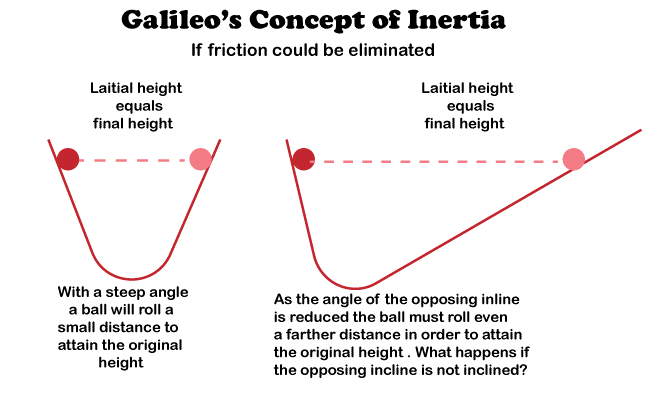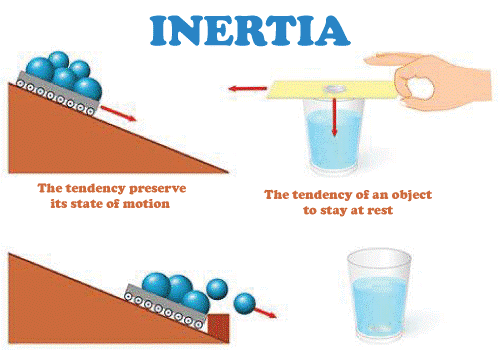Inertia DefinitionInertia is a property of an object which continues to stay in motion unless some force acts on it and changes its direction or motion. A body or an object keeps on moving because of the absence of force to compel it either to change its direction or speed or stop the object. A push or pull on an object or a body that results in its acceleration is referred to as force. A force is capable of changing the shape, speed, and direction of the body. Inertia can be measured in two numerical terms, i.e., mass and movement of inertia. Mass measures its resistance when force is applied, and movement of inertia measures the resistance action of a torque. The law of inertia is also known as newton's first law, which states that if a body or an object is stationary or at rest or moving at a constant speed in a line will remain at its position until and unless some force acts upon it. This law is the first one from the three laws of motion of Isaac newton. Galileo's explanation to InertiaGalileo stated that an object earns an equal amount of velocity in equal intervals of time when fallen. It implies that the speed of the object increases as it falls. Since, at that time, there was no technology available to record an object free falling motion speed, Galileo replaced the falling object with the ball rolling down an inclined surface or a vertical ram. He did so, considering a vertical ramp as free-falling. Galileo used a water clock to measure the time the rolling ball reached a certain distance down the inclined surface. He observed that the time taken by the ball to cover a particular distance was double the amount of time it took to cover a quarter of the distance. From all of this, Galileo concluded that if an object is in the stationary position, it gains speed when it falls freely or rolls an inclined surface, then the total distance will be proportional to the square of the time it took to cover. 
Different types of InertiaThere are three types of inertia- the inertia of rest, the inertia of direction, and the inertia of motion. The inertia of rest- When the body or object resists continuing in the situation of rest until any external force acts upon it, the body is referred to in the state of inertia of rest. The inertia of direction- When the body or object resists continuing in the motion in the same direction until any external force acts upon it, the body is referred to in the state of inertia of direction. The inertia of motion- When the body or object resists continuing in the state of uniform motion until an external force acts upon it, the body is referred to in the state of inertia of motion. 
Mass and moment of inertiaMass is the fundamental quantity and most basic of matter. It is the measure of the amount of matter in a body. The standard unit of mass is the kilogram. Since it has magnitude only, therefore, it is a scaler quantity. An object's mass does not change except when a large amount of energy is acted or taken from it. Inertia and mass are directly proportional and depend upon each other. It means the more the mass more will be its inertia. It implies a good amount of force is needed to change its rest or motion. Movement of inertia is a body or object's property in relational motion. It acts as an angular mass and therefore is known as rotational inertia. The standard unit of movement of inertia is a kilogram meter square. The density of the material used in the object, the axis of rotation, and the shape and size of the object affect the movement of inertia. The movement of inertia is always defined in relation to the axis. Axis can be internal or external or can be fixed or unfixed. The movement of inertia depends upon how the mass is distributed around the axis. Values of movement of inertia can vary depending on the location and direction of the rotational axis. There are two theorems for obtaining the movement of inertia.
Next TopicInflammation Definition
|
 For Videos Join Our Youtube Channel: Join Now
For Videos Join Our Youtube Channel: Join Now
Feedback
- Send your Feedback to [email protected]
Help Others, Please Share










